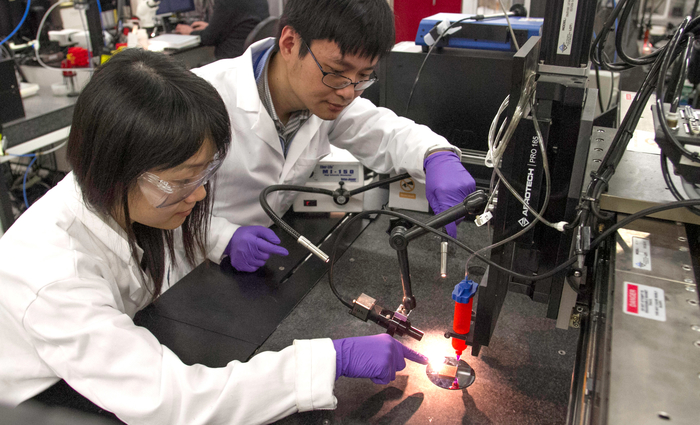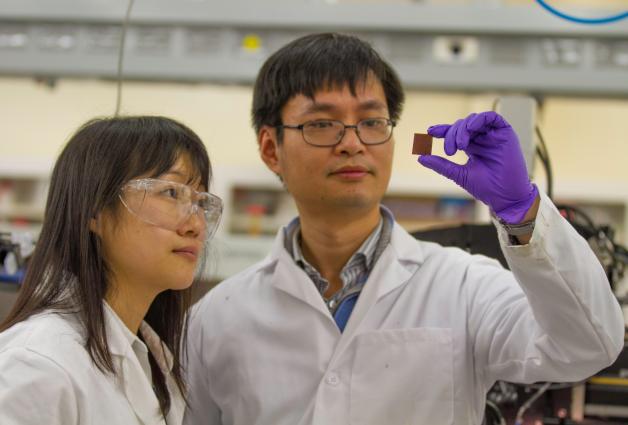Researchers 3D print ultralight supercapacitors
 (Download Image)
LLNL material and biomedical scientist Fang Qian (left) and engineer Cheng Zhu demonstrate a direct ink writing 3D printer they used to manufacture supercapacitors out of a graphene-based aerogel. Photos by Julie Russell/LLNL
(Download Image)
LLNL material and biomedical scientist Fang Qian (left) and engineer Cheng Zhu demonstrate a direct ink writing 3D printer they used to manufacture supercapacitors out of a graphene-based aerogel. Photos by Julie Russell/LLNL
For the first time ever, scientists at Lawrence Livermore National Laboratory and UC Santa Cruz have successfully 3D-printed supercapacitors using an ultra-lightweight graphene aerogel, opening the door to novel, unconstrained designs of highly efficient energy storage systems for smartphones, wearables, implantable devices, electric cars and wireless sensors.
Using a 3D-printing process called direct-ink writing and a graphene-oxide composite ink designed at the Lab, the LLNL team was able to print micro-architected electrodes and build supercapacitors able to retain energy on par with those made with electrodes 10 to 100 times thinner.
The results were released online in the journal Nano Letters on Jan. 28.
"This breaks through the limitations of what 2D manufacturing can do," said engineer Cheng Zhu, the paper’s lead author. "We can fabricate a large range of 3D architectures. In a phone (for instance) you would only need to leave a small area for energy storage. The geometry can be very complex."
Supercapacitors also can charge incredibly fast, Zhu said, in theory requiring just a few minutes or seconds to reach full capacity. In the future, Zhu and his fellow researchers believe newly designed 3D-printed supercapacitors will be used to create unique electronics that are currently difficult or even impossible to make using other synthetic methods, including fully customized smartphones and paper-based or foldable devices, while at the same time achieving unprecedented levels of performance.
"We’re pioneering the marriage of 3D-printing and porous materials," said material and biomedical scientist Fang Qian, a co-author on the paper. "Think of a supercapacitor as a portable energy device, so anything that needs electricity would benefit from such a supercapacitor. If we can replace the standard (technology) with our lightweight, compact and high-performance supercapacitor, that would be a radical change."
Graphene-based inks, the researchers said, have a distinct advantage over carbon-based materials due to their ultrahigh surface area, lightweight properties, elasticity and superior electrical conductivity. The graphene composite aerogel supercapacitors also are extremely stable, the researchers reported, capable of nearly fully retaining their energy capacity after 10,000 consecutive charging and discharging cycles.
"Additively manufactured 3D architectures for energy storage will improve energy and power characteristics for supercapacitors, enabling lightweight, miniaturized power sources," said LLNL materials engineer Eric Duoss. "Graphene is a really incredible material because it is essentially a single atomic layer that can be created from graphite. Because of its structure and crystalline arrangement, it has really phenomenal capabilities."
The Lab researchers worked closely with UC Santa Cruz professor Yat Li and grad student Tianyu Liu, who performed the electrochemical characterizations and optimized the materials used in the process.
Over the next year, the researchers intend to expand the technology by developing new 3D designs, using different inks and improving the performance of existing materials.
"This is definitely a first step toward the future," Zhu said. "There will be more to come."
Funding for the research came from the internal Laboratory Directed Research & Development (LDRD).
Contact
 Jeremy Thomas
Jeremy Thomas
[email protected]
(925) 422-5539
Related Links
Supercapacitors Based on Three-Dimensional Hierarchical Graphene Aerogels with Periodic MacroporesLLNL Additive Manufacturing
3D-printed aerogels improve energy storage
Tags
Laboratory Directed Research and DevelopmentLaboratory for Energy Applications for the Future
Engineering
Featured Articles








